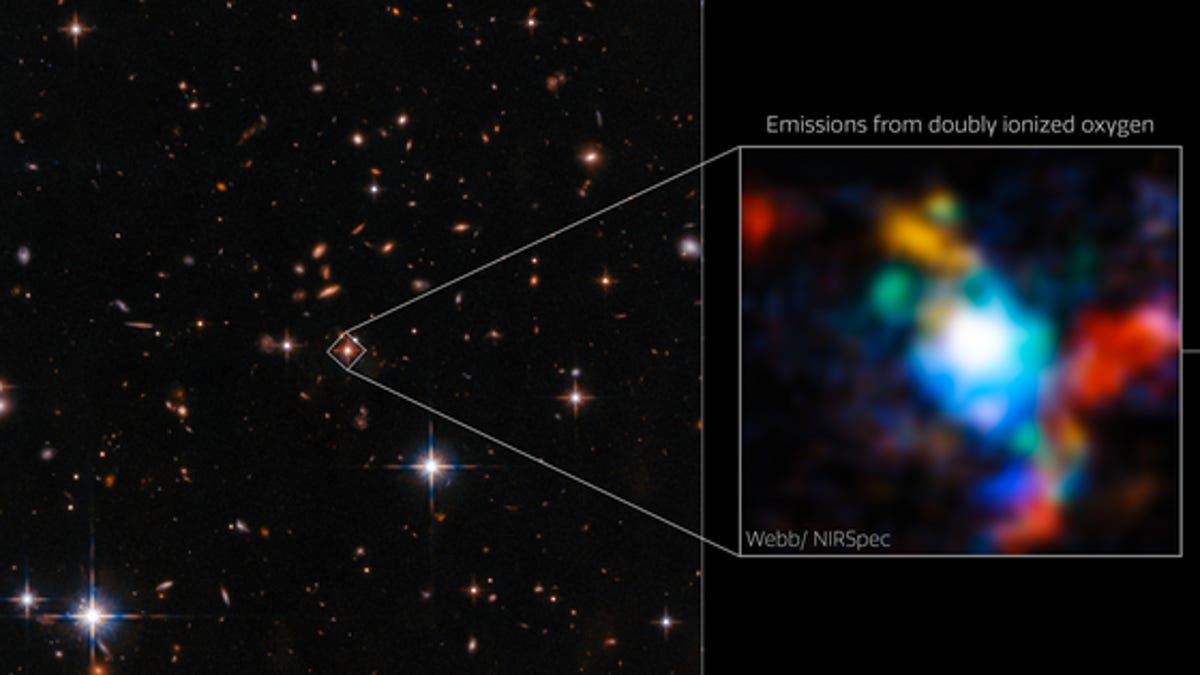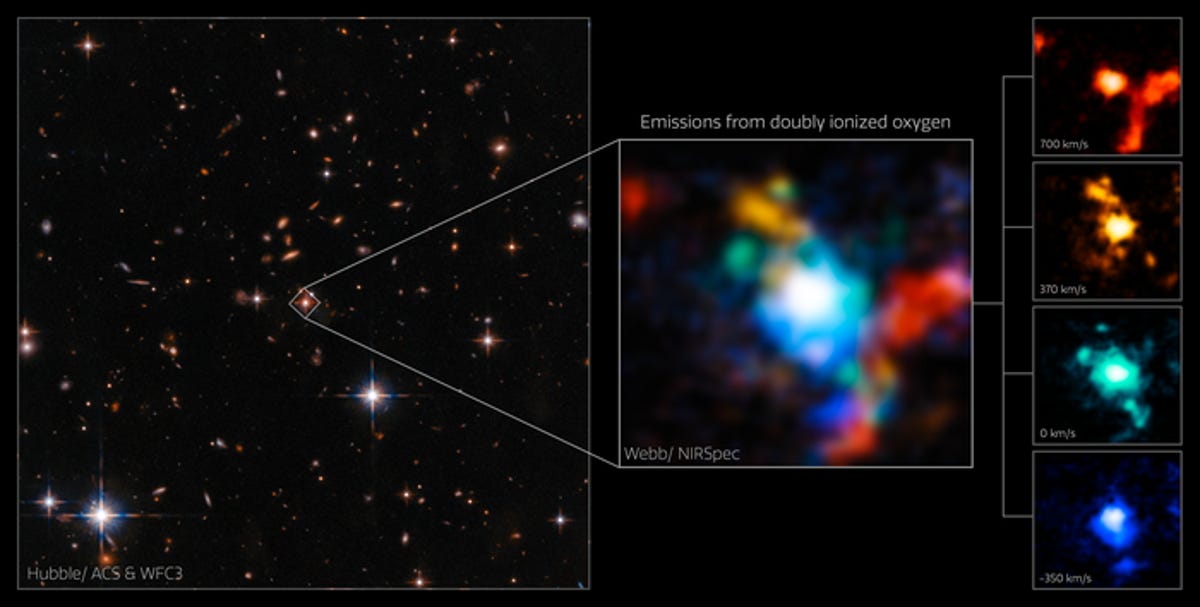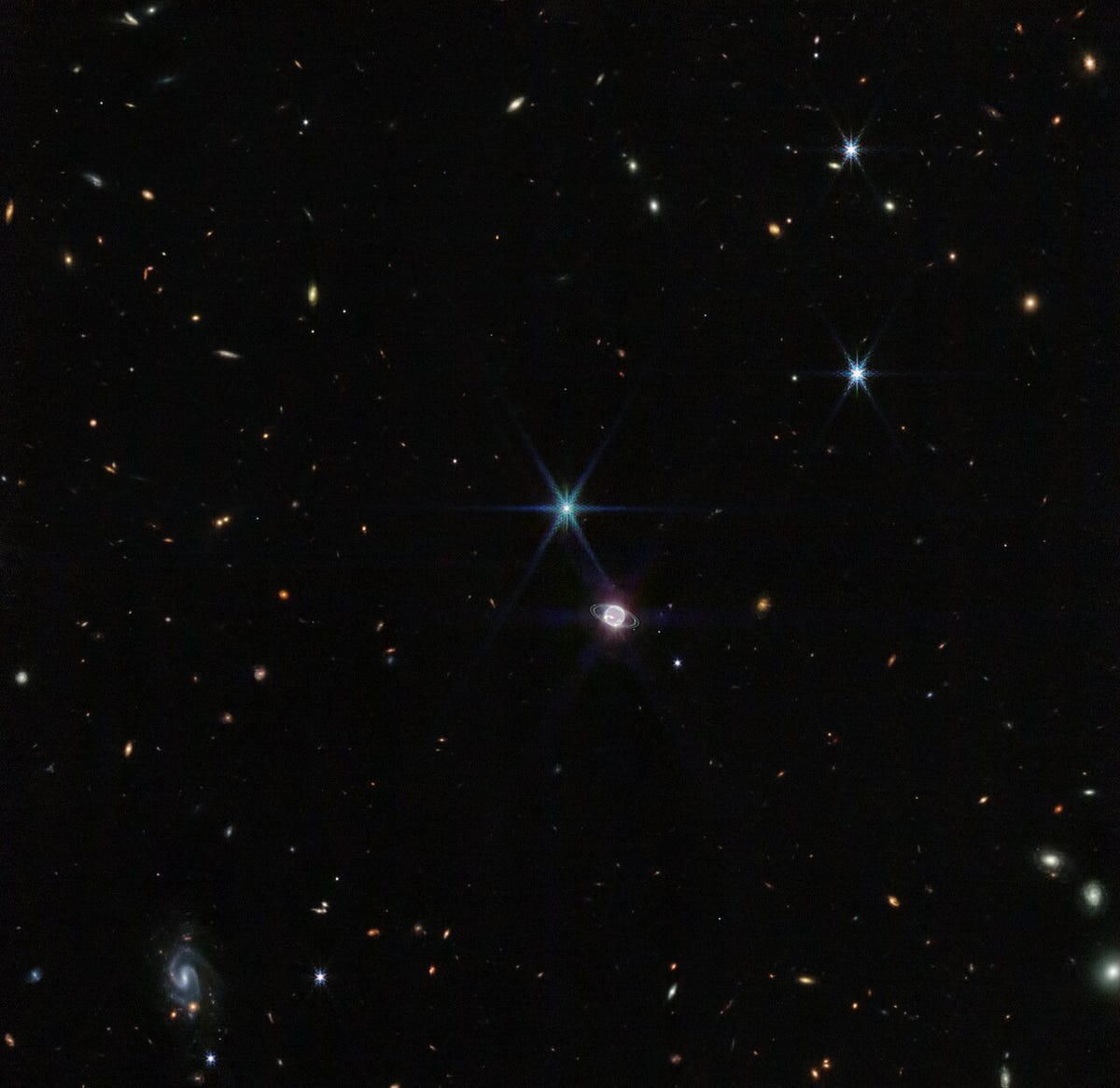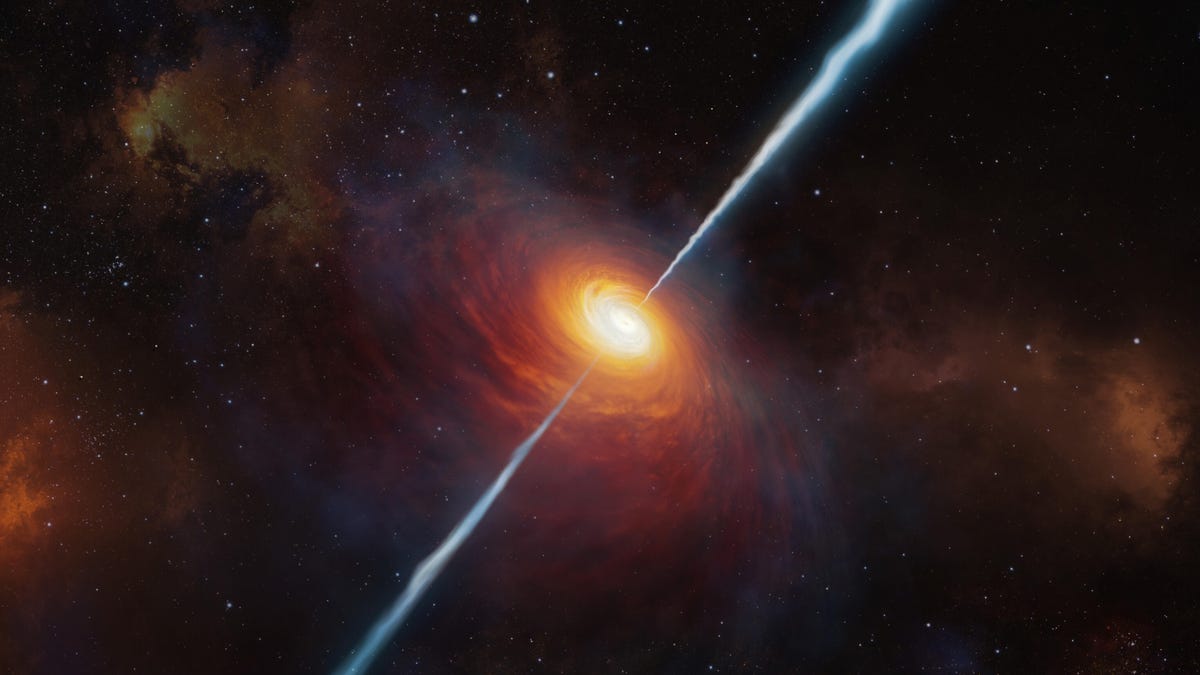
Posted on 10/24/2022 1:13:35 PM PDT by Red Badger

On the left is a Hubble image of many faraway galaxies against the dark background of space. In the middle is a blown-up portion of the Hubble image, highlighting in various colors what the JWST's view of the galaxy merger looks like. On the right, each color from the image is separated so as to show the different velocities present.
What you're looking at is evidence of a massive galaxy merger happening 11.5 billion light-years away.
ESA/Webb, NASA & CSA, D. Wylezalek, A. Vayner & the Q3D Team, N. Zakamska
Now that we have a powerful lens pointed toward the deepest regions of the universe at all times, our definition of "surprise" has slightly altered when it comes to astronomy pics.
It's no longer surprising, really, when NASA's James Webb Space Telescope reveals yet another brilliant, ancient piece of the cosmos. At this point, we know to expect nothing less from the trailblazing machine.
Instead, whenever the telescope sends back a jaw-dropping space image, it now elicits more of a "JWST strikes again!" feeling. And still, our jaws legitimately drop every single time.
This sort of dissonant version of "surprise" has happened yet again -- to a pretty extreme degree. Last week, scientists presented the JWST's brilliant view of a galaxy cluster merging around a massive black hole that houses a rare quasar -- aka an incomprehensibly bright jet of light spewing from the void's chaotic center.
There's a lot going on here, I know. But the team behind the find thinks it could escalate even further.
"We think something dramatic is about to happen in these systems," Andrey Vayner, a Johns Hopkins astronomer and co-author of a study about the scene soon to be published in the Astrophysical Journal Letters, said in a statement. For now, you can check out a detailed outline of the discovery in a paper published on arXiv.
 An artist's concept of a galaxy with a brilliant quasar at its center.
An artist's concept of a galaxy with a brilliant quasar at its center.
NASA, ESA and J. Olmsted (STScI)
Especially fascinating about this portrait is that the quasar at hand is considered an "extremely red" quasar, which means it's super far away from us and therefore physically rooted in a primitive region of space that falls near the beginning of time.
In essence, because it takes time for light to travel through space, every stream of cosmic light that reaches our eyes and our machines is seen as it was long ago. Even moonlight takes about 1.3 seconds to reach Earth, so when we peer up at the moon, we're seeing it 1.3 seconds in the past.
More specifically with this quasar, scientists believe it took about 11.5 billion years for the object's light to reach Earth, meaning we're seeing it as it was 11.5 billion years ago. This also makes it, according to the team, one of the most powerful of its kind observed from such a gargantuan distance (11.5 billion light-years away, that is).
"The galaxy is at this perfect moment in its lifetime, about to transform and look entirely different in a few billion years," Vayner said of the realm in which the quasar is anchored.
Analyzing a galactic rarity
In the colorful image provided by Vayner and fellow researchers, we're looking at several things.
 Each color in this image represents material moving at a different velocity.
Each color in this image represents material moving at a different velocity.
ESA/Webb, NASA & CSA, D. Wylezalek, A. Vayner & the Q3D Team, N. Zakamska
On the left is a Hubble Space Telescope view of the region studied by the team, and in the middle is a blown-up version of the spot that the JWST zeroed-in on. Glance to the far right of this image, where four individually color-coded boxes are seen and you'll be analyzing different aspects of the JWST data broken down by velocity.
Red stuff is moving away from us and blue toward us, for instance.
This classification shows us how each of the galaxies involved in the spectacular merger are behaving -- including the one that holds the extreme black hole and accompanying red quasar, which is, in fact, the only one the team expected to uncover with NASA's multibillion dollar instrument.
"What you see here is only a small subset of what's in the data set," Nadia L. Zakamska, a Johns Hopkins astrophysicist and co-author of the study, said in a statement. "There's just too much going on here so we first highlighted what really is the biggest surprise. Every blob here is a baby galaxy merging into this mommy galaxy and the colors are different velocities and the whole thing is moving in an extremely complicated way."
Now, Zakamska says, the team will start to untangle the motions and enhance our view to an even greater extent. Already, though, we're looking at information far more incredible than the team expected to begin with. Hubble and the Gemini-North telescope previously showed the possibility of a transitioning galaxy but definitely didn't hint at the swarm we can see with the JWST's awesome infrared equipment.

Toward the center, slightly southwest, is a glowing circle depicting Neptune. Faint rings, also glowing, are seen encircling the orb. Northwest of this globe is a six-spiked, bright bluish fixture representing one of Neptune's moons. Tons of spots and swi In another spectacular image taken by Webb's Near-Infrared Camera (NIRCam), a smattering of hundreds of background galaxies, varying in size and shape, appear alongside the Neptune system.
ESA
"With previous images, we thought we saw hints that the galaxy was possibly interacting with other galaxies on the path to merger because their shapes get distorted in the process," Zakamska said. "But after we got the Webb data, I was like, 'I have no idea what we're even looking at here, what is all this stuff!' We spent several weeks just staring and staring at these images."
Soon enough, it became clear that the JWST was showing us at least three separate galaxies moving incredibly fast, the team said. They even believe this could mark one of the densest known areas of galaxy formation in the early universe.

An artistic impression of the quasar P172+18, which is associated with a black hole 300 times more massive than the sun.
ESO/M. Kornmesser
Everything about this complex image is mesmerizing. We have the black hole, that Zakamska calls a "monster," a highly rare jet of light being spit from that black hole and a gaggle of galaxies on a collision course -- all seen as they were billions of years in the past.
So, dare I say it? The JWST strikes again, offering us an exceedingly precious cosmic vignette. Cue, jaw drop.
Traveling all that time and it never got tired.
...but our SUVs will destroy the planet...
you dont understand... if “Galaxies” that are millions of light years across like ours is. showing up THAT small and blurry, any movemnet of 1 fraction of the size of the galaxy would equate to 50,000 to 100,000 years!!! these friggin people make it sound like clouds on your doppler example. that they see em move in real time!!
“I hope this does not happen to our galaxy. “
If it does, we can be sure our rulers will insist that global socialism is the only way to save ourselves.
Jim Morrison.
Universal accelerated expansion is driven by expanding space. This would also mean that space is accelerated-ly shrinking the event horizons and accretion disks around black holes, and introducing more mass into 3-dimensional space at an accelerating rate.
It has been said that the Northern Hemisphere civilization developed more rapidly than the Southern Hemisphere merely due to the fact that the Northern Hemisphere has Polaris (the North Star).
never heard that but it seems logical... we were able to use it to navigate thus learning from and building on the jones’s!!
Southern cross works pretty good also.
Ford stopped making the Galaxie in 1974 and the last Quasar TVs were make in 2005.
Yes! If the universe, or what I like to call “existence” is infinite, then it goes without saying biological intelligence would exist. It’s mind bending, but I tell you, and people do not believe me when I say this: I remember being in the womb. I remember being smaller than the smallest and when I was a toddler, I use to freak out about it, so it makes me wonder how is that possible unless there is a soul?
Maybe recently, but Polaris was not always the pole star.
https://earthsky.org/astronomy-essentials/north-star-movement/
Taking turns as the North Star
A motion of Earth called precession causes our axis to trace out an imaginary circle on the celestial sphere every 26,000 years. Thousands of years ago, when the pyramids were rising from the sands of ancient Egypt, the North Star was an inconspicuous star called Thuban in the constellation Draco the Dragon. Twelve thousand years from now, the blue-white star Vega in the constellation Lyra will be a much brighter North Star than our current Polaris.
Polaris could be a name for any North Star. Our current Polaris used to be called Phoenice. It is the 49th brightest star in the sky. It is not known for its brightness, but for its unique position in the sky.
I’m sorry, that’s not how the Doppler effect works. It doesn’t matter how big or far away the source of light is. The light it gives off will shift to higher or lower frequency depending on its speed relative to the observer. This tells you how fast it is either approaching or receding. You don’t actually have to see it moving. This is how cops can instantly tell exactly how fast your car is going using a radar gun.
i do not believe they are even remotely the same. there is no way that movement can be detected in a span of say ten years that is 1.5 billion light years away. unless they can physically show me 3 individual frames that differ showing the movement. And I doubt then i’d fully buy it! the colors you see are not temperatures or speeds. they are added for visual purposes to show the different galaxies...
I’ve followed these threads for years and mainly because the fake news/photos from APOD CONSTANTLY, i find it hard to believe ANYTHING out of the space agency anymore.
As I said, it has nothing to do with detecting movement, but what the Doppler shifting of its light tells you. This technology has been around for a long time. You may believe what you wish, however.
It’s rare, safe and effective...................😜
We will know when the “BIG ONE” is coming...................
Differing amounts of Red Shift.....................
We can see things 11.5 billion light years away but can’t know who won an election on election night. Yea, right.
the displacement of spectral lines toward longer wavelengths (the red end of the spectrum) in radiation from distant galaxies and celestial objects. This is interpreted as a Doppler shift that is proportional to the velocity of recession and thus to distance.
Input mode is not totally shut down over here. And this minute mind slightly understands this red shift theory however... I'm still of mind that regardless of how it's detected, that size and object... Millions of light years of size, and billions of lights years away, would have to be moving at an extremely astronomical rate to be detected in a span of 5... 10... 15 years. And if the big bang theory is true all these galaxies should be moving close to parallel not coming into each other from different angles... I must be missing something huge lol... Blame my trust of modern chemistry in the 70s for it!!
Disclaimer: Opinions posted on Free Republic are those of the individual posters and do not necessarily represent the opinion of Free Republic or its management. All materials posted herein are protected by copyright law and the exemption for fair use of copyrighted works.